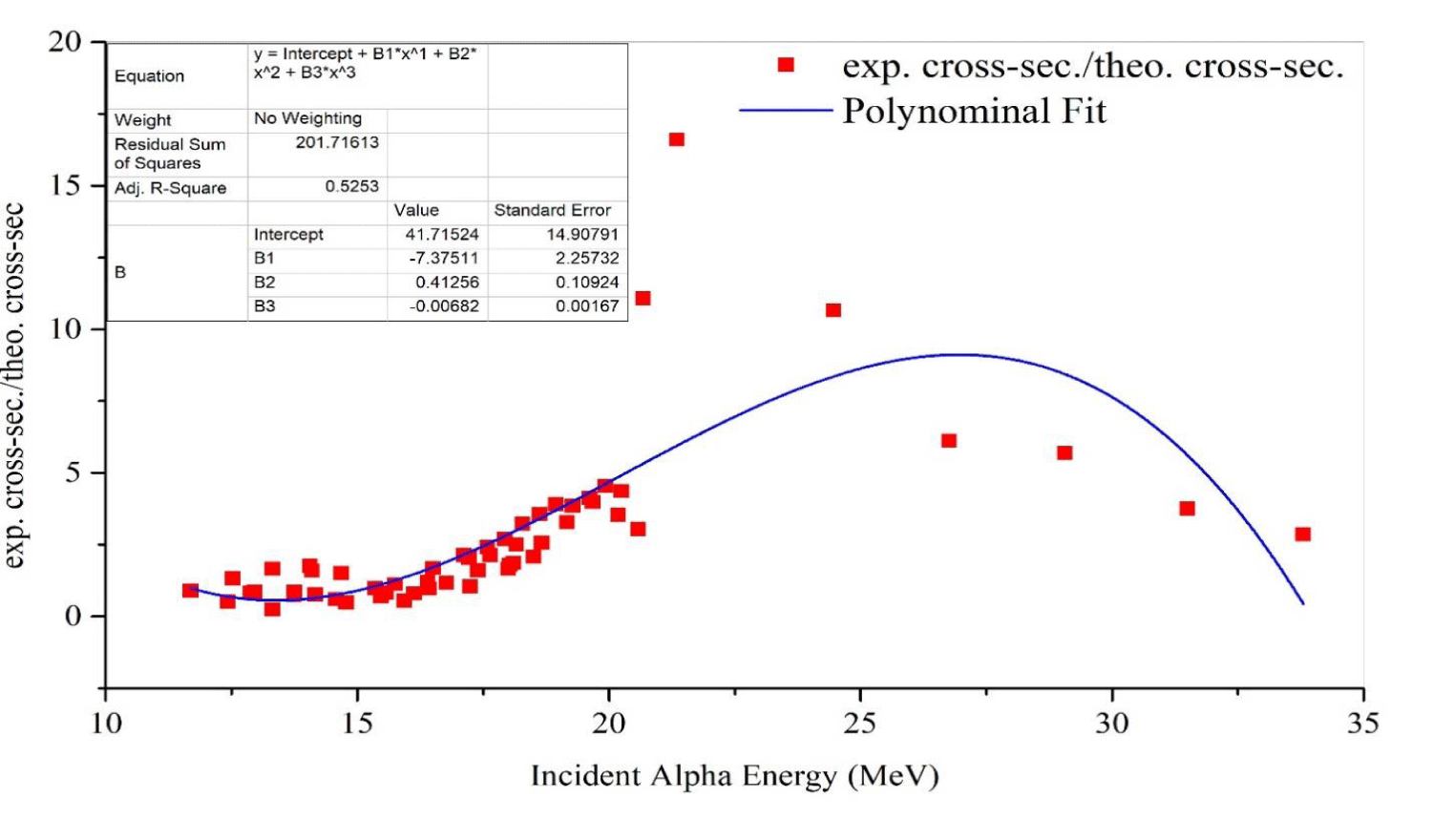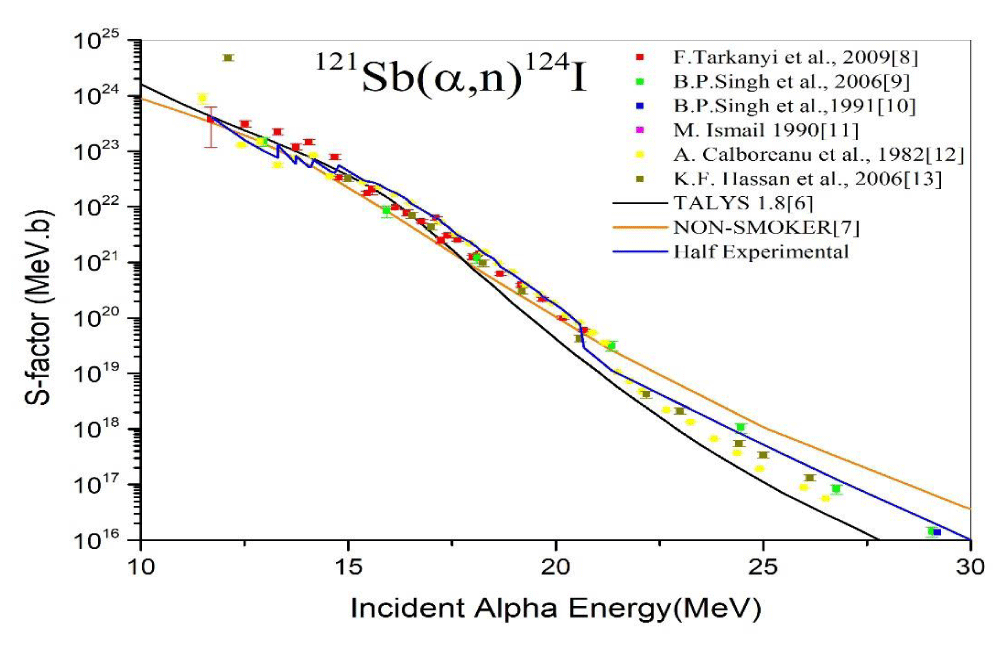> Medicine Group. 2021 Apr 22;2(4):296-299. doi: 10.37871/jbres1229.
Obtaining Astrophysical S-Factors and Half-Experimental Cross-Section Values for 121Sb (α, n) 124I Reaction
Ercan Yıldız*
- Radionuclide
- Cross-section
- EXFOR
- TALYS 1.8
Abstract
In this study, 121Sb (α, n) 124I reaction, which is one of the production reactions of the 124I radioisotope, which has an important use in nuclear medicine, was investigated. Experimental value EXFOR was obtained and theoretical data was obtained using TALYS 1.8 and NON-SMOKER half-experimental cross section values were calculated using theoretical data and experimental values. In addition, the Astrophysical S-factor was calculated. The obtained results were compared with EXFOR data.
Introduction
Although nuclear power plants come to mind when it comes to nuclear physics, developments in the field of nuclear physics also contribute to the development of the health sector. Especially, radioisotopes produced in particle accelerators and reactors are frequently used in cancer treatment.
The use of radioisotopes in the biological sciences begins in 1923 with the work of von Hevesy. Hevesy has shown that the amount of radiation needed for such studies should be very small. At the time, the radioisotopes needed for such studies were not yet available. This problem was solved when Curie and Joliot discovered in 1934 that radioisotopes could be artificially produced [1].
124I (T1/2 = 4,18 day; Eβ+ = 2,13 MeV; Iβ+ = %22) radionuclide; It is one of the important positron emitters for nuclear medicine with its suitable uses for radio immunotherapy with Positron Emission Tomography (PET) [2].
Cross-section measurements, astrophysical S-factor calculation studies provide the opportunity to test statistical models [3].
The experimental and theoretical cross sections of the 121Sb (α, n) 124I reaction, which plays a particularly important role in the production of 124I, were considered and half-experimental cross section values were calculated.
Astrophysical S-factor the major typical of a reaction is the cross section σ(E), which has the size of a superficial and related on energy also the cross section at stellar energies is governed by Coulomb effects. The astrophysical S-factor is defined as
(1)
where, η is the Sommerfeld parameter, (Z1Z2e2)/ħν. The astrophysical S-factor is particularly useful in low energy regions. Empirical measurements of σ (E) at low energies measurement are mostly not available (because of the Coulomb barrier exponentially depress low-energy cross sections) [4].
Materials and Methods
In this study, experimental values for σ(exp) 121Sb (α, n) 124I from 124I production reactions were obtained from the EXFOR [5] database. For theoretical values, the theoretical cross-section σ(exp) values were obtained by running TALYS 1.8 [6] with the values taken from the EXFOR [5] database. In addition, NON-SMOKER [7] were used to compare values.
σ(exp) [8-13]/σ(theo)[6] a graph was drawn according to the incoming alpha energy. The polynomial fit procedure was applied on this drawn graph. The values obtained were obtained by obtaining a function dependent on energy f (E) and half-experimental cross section formula was obtained for any energy interval [14].
(2)
with the polynomial fit values we obtained from figure 1, f(E) = 41.71524-(7.37511.E) + (0.41256.E2)-(0.00682.E3) was obtained. By putting these values in place in equation number 2, figure 3 is obtained. This half-experimental cross section value obtained was compared with the theoretical values.
EXFOR
EXFOR [5] data library is a comprehensive collection of experimental nuclear reaction data, stored and reused. EXFOR web database access system; It has many services such as data search, output in various formats, drawing comparison with ENDF, rearranging old data to new standards, inverse reactions and calculating data, creating correlation matrices from partial uncertainties.
TALYS (Nuclear Reaction Code)
The TALYS 1.8 [6] nuclear code program determines all reaction mechanisms, reaction channels and all observable possibilities using nuclear models. In the simulation reactions created in this program, it can operate in the energy region of 1 keV –1 GeV with n, p, d, t, 3He, α particles and γ beams as bullet particles. The mass of the target nucleus is between 5 NON-SMOKER [7] is a computer code using the Hauser-Fesbach Model that theoretically calculates cross section values.Non-smoker
Results and Discussion
When figure 2, was examined, it was seen that the half-experimental cross section values, especially in the range of 11-16 MeV, were compatible with the TALYS 1.8 [6] and NON-SMOKER [7,8] and [9-11] values. This harmony is especially similar to [12] and [13], TALYS 1.8 [6], NON-SMOKER [7] values after 20 MeV. Half-experimental cross section values gave very consistent results.
The astrophysical S-factor values obtained by putting the values in figure 2, in their places in equation 1 are shown in figure 3. Astrophysical S-factor values, which give valuable results especially for low energy regions, gave almost similar results when figure 3.
The half-experimental cross-section and astrophysical S-factor values we calculated in the range of 15-20 MeV, where experimental data are intense, are in great harmony. This harmony becomes more pronounced especially in the NON-SMOKER values.
It is thought that half-experimental studies will make a significant contribution especially for situations where experimental study opportunities and conditions are insufficient.
Understanding the production mechanisms and theoretical calculations of radioisotopes is important for situations where experimental studies cannot be conducted. It is believed that the half-experimental cross-section and astrophysical S-factor values that we calculated in this study will be useful for situations where these experimental studies cannot be performed. It is thought that the study will contribute to the acquisition processes of different radioisotopes, which have an important place in the field of health.
The TALYS 1.8 nuclear code program gave results consistent with the half-experimental cross-sectional values we calculated. It is thought that using such code programs will be very useful in understanding nuclear reactions. It is assumed that it will contribute to the development of programs such as TALYS 1.8 with the increase of half-experimental studies.
Experimental studies required for nuclear reactions are not always possible in terms of both material and possibilities. It is not always possible to obtain and use reactants. In such cases, it is advantageous to make theoretical experiments or to make half-experimental calculations with various simulation programs.
References
- Ercan MT. Tıp’da Radyoizotoplar. Turkiye Klin. J Med Res. 1985;3:201-202.
- Demirkayık M. The Calculation of Cross-section of iodine-124 Radioisotope Produced by Different Reactions on Antimony Targets. Kırıkkale University. 2014.
- Basunia MS, Norman EB, Shugart HA, Smith AR, Dolinski MJ, Quiter BJ. Measurement of cross sections for the 63Cu(α,γ)67Ga reaction from 5.9 to 8.7MeV. Jour Phys Rev. 2005. https://bit.ly/3ezESgz
- Yildiz E, Aydin A. Calculation of Cross-sections and Astrophysical S-Factors for 62Ni(α,n) and 62Ni(α,γ) Reactions of Structural Fusion Material Nickel. J Fusion Energy. 2016;35:605-607. https://bit.ly/3dCSDLT
- EXFOR, (Experimental Nuclear Reaction Data File). Brookhaven National Laboratory, National Nuclear Data Center.
- Koning GSA, Hilaire S. TALYS–1.8. 2017. https://bit.ly/3sBacQP
- Rauscher T. NON-SMOKER. 2000. https://bit.ly/3nikxQR
- Tárkányi F, Takács S, Király B, Szelecsényi F, Andó L, Bergman J, Heselius SJ, Solin O, Hermanne A, Shubin YN, Ignatyuk AV. Excitation functions of 3He- and alpha-particle induced nuclear reactions on natSb for production of medically relevant 123I and 124I radioisotopes. Appl Radiat Isot. 2009 Jun;67(6):1001-6. doi: 10.1016/j.apradiso.2009.02.067. Epub 2009 Feb 26. PMID: 19324559.
- Singh BP, Sharma MK, Musthafa MM, Bhardwaj HD, Prasad R. A study of pre-equilibrium emission in some proton- and alpha-induced reactions. Nucl Instruments Methods Phys Res Sect A. Accel Spectrometers Detect Assoc Equip. 2006;562:717-720. https://bit.ly/3x8khs9
- Singh BP. A study of pre-equilibrium emission in a-induced reactions on 121,123 Sb. J Chem Inf Model. 1990;53:1689-1699. https://bit.ly/3nil1Xb
- Ismail M. Measurement and analysis of the excitation function for alpha-induced reactions on Ga and Sb isotopes. J Chem Inf Model. 1990;531689-1699. https://bit.ly/32vSN1k
- Calboreanu A, Pencea C, Salagean O. The effect of gamma de-excitation competition on the (α, n) and (α, 2n) reactions on gold and antimony. Nucl Physics Sect A. 1982;383:251-263. https://bit.ly/2P9liyX
- Hassan KF, Qaim SM, Saleh ZA, Coenen HH. Alpha-particle induced reactions on natSb and 121Sb with particular reference to the production of the medically interesting radionuclide 124i. Appl Radiat Isot. 2006;64:101-109. https://bit.ly/3auwgX3
- Gökmen A. The Investigation of Different Production Methods of Positron Emitter Bromine-76 Radioisotope. Kırıkkale University. 2013.
Content Alerts
SignUp to our
Content alerts.
 This work is licensed under a Creative Commons Attribution 4.0 International License.
This work is licensed under a Creative Commons Attribution 4.0 International License.











